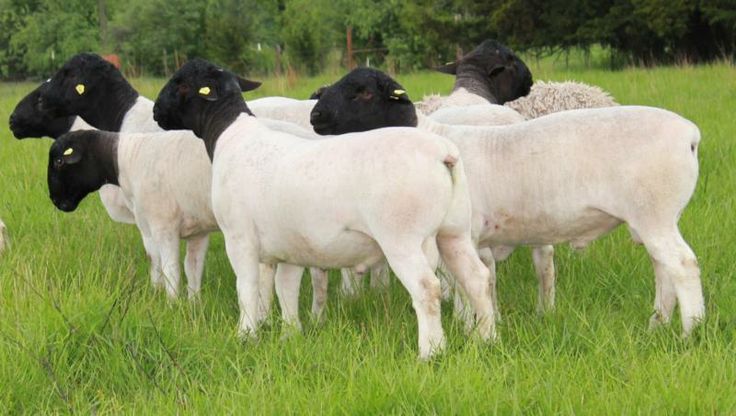

A Dorper is a fast growing meat producing sheep. The Dorper is an easy care animals that produces a fleece of little wool) that is shed late spring summer. It was developed in South Africa and is now the second most popular breed in that country. The Dorper Sheep Breeders Society of SA was founded in 1950.
This breed was developed by the crossing of a Dorset Horn x Blackhead Persian around the 1930s. Other breeds such as the Van Rooy are also believed to have contributed to the development of the breed. The name ‘Dorper’ is a coupling of the first syllables of the parent breeds Dorset and Persian.
The breed is well adapted to survive in the arid extensive regions of South Africa. It has high fertility and maternal instinct, combined with high growth rates and hardiness. The breed has the characteristic black head as well as white heads (White Dorper).
This resulted in the birth of mainly black and a few white Dorper lambs. The difference in colour is therefore, merely a matter of preference for each breeder. Black-headed breeders constitute about 85% of the members of the Dorper Sheep Breeders’ of Society of South Africa. The Dorper is the second largest breed in South Africa and has spread to many other countries throughout the world.
Mutton production
The Dorper is primarily a mutton sheep. The breed was developed for the arid regions of South Africa to convert low quality roughage into high quality lamb. The ram of this breed is an ideal sire for prime lamb production. Inherent characteristics of the breed such as rapid growth rates, good muscling, ability to produce low fat scores make them ideal for the domestic and export trade. The Dorper has a long breeding season which is not seasonally limited, so under intensive management three lambings in two years may be possible.
Lambing percentages in South Africa of 150% are not uncommon. Rams reach sexual maturity at an early age, rams have been observed to start working by five months. Live weight gains that allow lambs to reach about 36kg 17-18kg carcase in 100 days has been obtained from first cross animals grown in the Mallee region. Local experience indicates that carcases with fat scores of 2 to 3 to be easily obtained under these conditions.
Physical requirements
The Dorper adapts well to a variety of climatic and grazing conditions. In its native South Africa it has spread from the arid areas to all parts of the republic. It reputably does well in various range and feeding conditions and is also suited to intensive feeding. In Australia, Dorpers could be run as a complementary flock to merinos, particularly as shearing costs continue to rise and wool prices fall.
Production
The breed is extremely adaptable with a high ability to flourish, grow, produce and reproduce in irregular and low rainfall environments. Dorpers are known to adapt well to feed lot conditions which offers farmers an alternative method to finish lambs in times of drought. The breed is regarded, as having the ability to graze and browse which suggests it will consume plants seldom eaten by the Merino.
The Dorper is an easy care breed, which requires minimal input of labour. The Dorper has a thick skin, which is highly prized and protects the sheep under harsh climatic conditions. The Dorper skin is the most sought after sheepskin in the world and is marketed under the name of Cape Glovers. The skin comprises a high percentage of the income (20%) in South Africa. Management is as for merinos, but Dorpers do not need shearing, crutching, mulesing and they don’t get flystrike.
 Contact Jaguza Support
Contact Jaguza Support